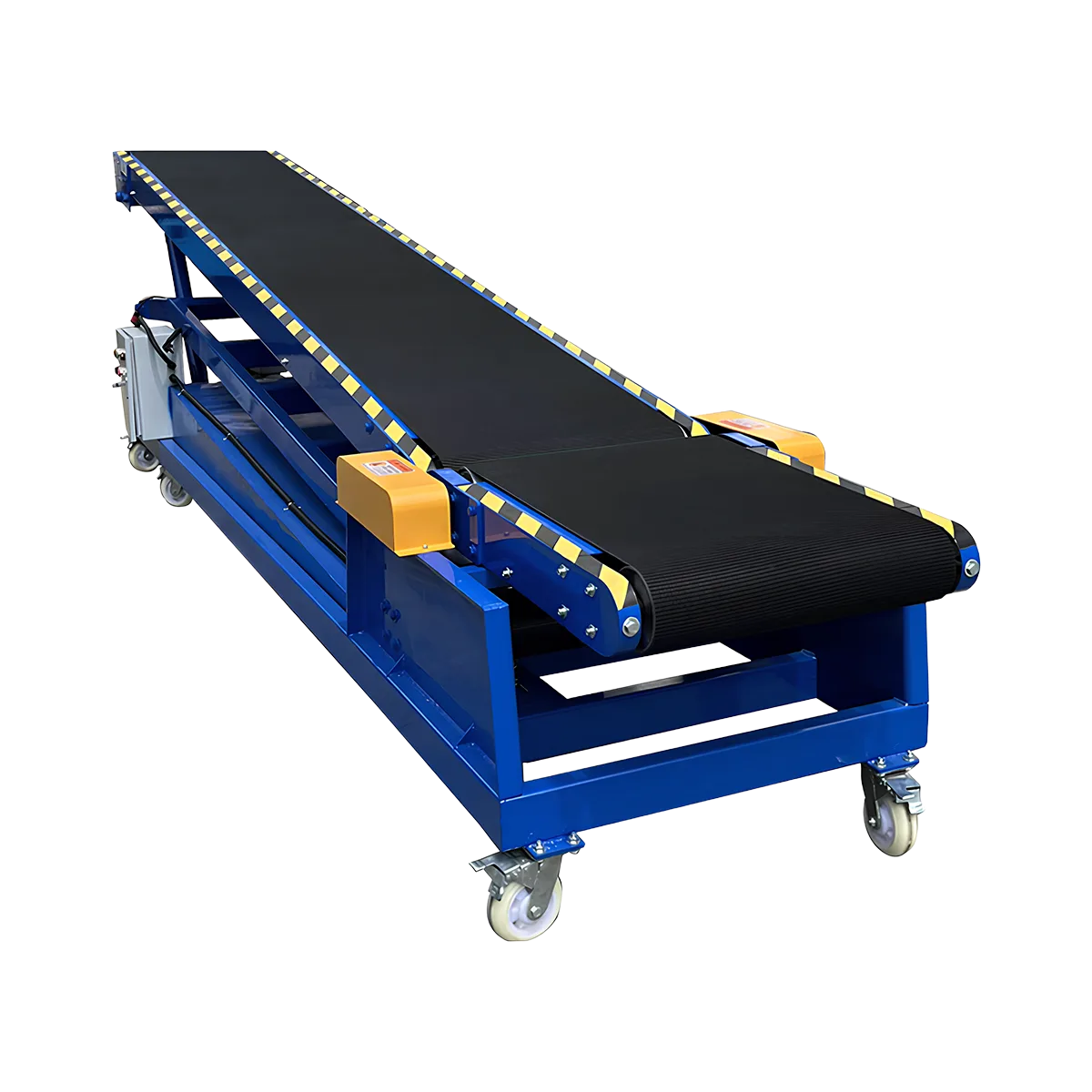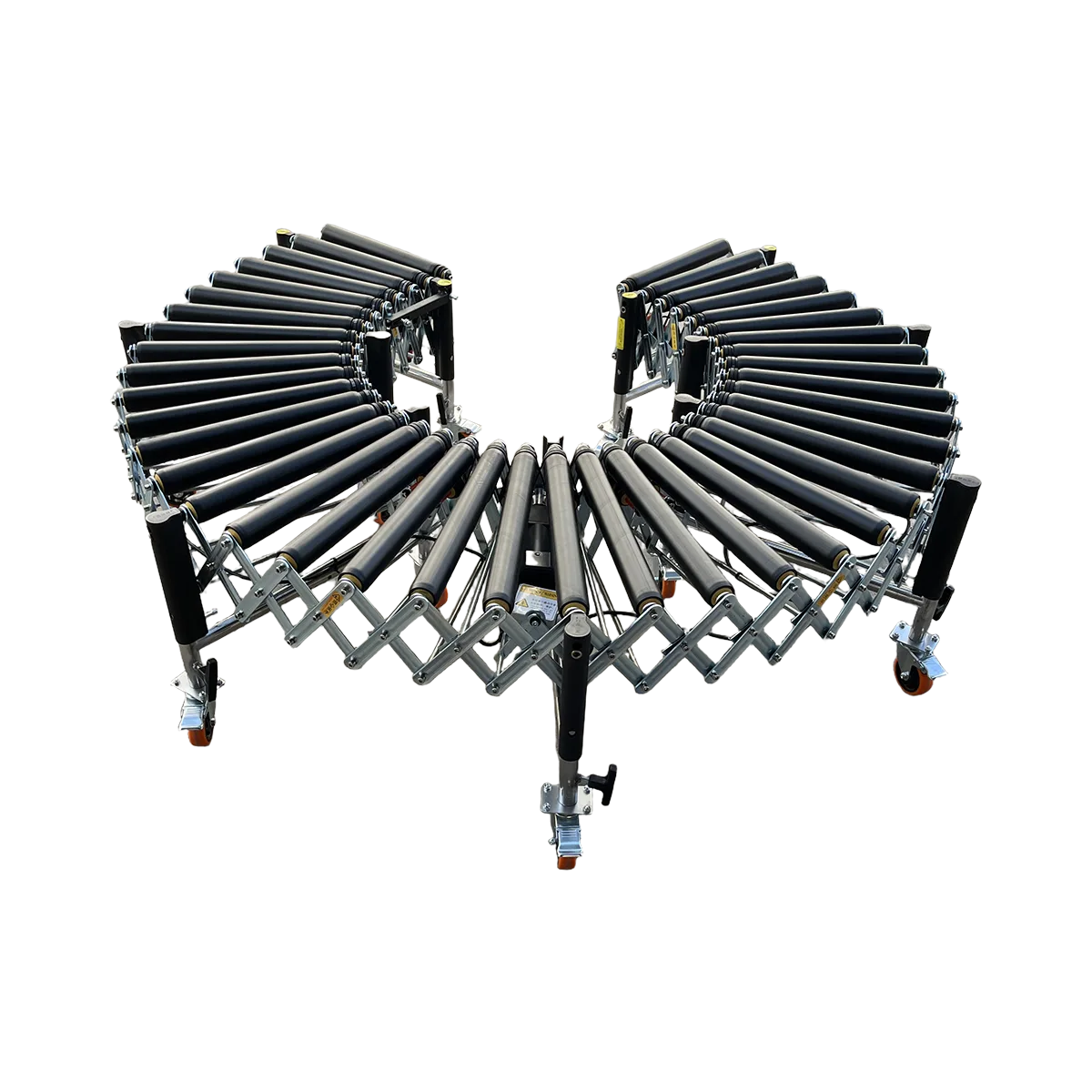How to Safely Convey 50kg Sacks of Seeds, Feed, and Grain
Discover how to efficiently transport heavy agricultural bags with specialized agricultural conveyor for bags that provides superior grip and stability for loading feed sacks.
Related Products
-
Hydraulic Conveyor – Large – 7900 mm LengthCollapsed LengthExtended LengthLoad Capacity
80 kg/m
Applicable GoodsFlat-bottomed Goods
Bagged Goods
-
Hydraulic Conveyor – Medium – 7000 mm LengthCollapsed LengthExtended LengthLoad Capacity
80 kg/m
Applicable GoodsFlat-bottomed Goods
Bagged Goods
-
Powered Rubber Roller Conveyor – Multi-wedge Belt Driven – 1100 mm/SectionCollapsed Length
560 mm
Extended Length1100 mm
Load Capacity120 kg/m
Applicable GoodsFlat-bottomed Goods
Bagged Goods
In the agricultural sector, moving heavy sacks of seeds, feed, and grain is a daily challenge that requires specialized equipment. Traditional material handling methods often lead to worker fatigue, potential injuries, and inefficient operations. An agricultural conveyor for bags designed specifically for these heavy, sometimes slippery items can transform your operation’s efficiency and safety. This guide explores how to safely and effectively transport these challenging loads using the right conveyor technology.
The Challenge of Moving Heavy Agricultural Bags
Agricultural operations face unique challenges when handling bagged products:
- 50kg sacks of seeds, feed, and grain create significant physical strain on workers
- Woven polypropylene or paper bags can slip on standard metal rollers
- Inclined transport is often necessary to reach silos, trucks, or elevated storage
- Bags can tear or burst if handled improperly
- Inconsistent bag shapes create stability issues during transport
- Dust and debris from agricultural products can affect equipment performance
The most significant challenge occurs when attempting to move these heavy bags up an incline. Standard metal roller conveyors simply don’t provide enough friction, causing bags to slip backward or slide sideways. This not only slows operations but creates dangerous situations where heavy bags might fall onto workers or damage equipment.
Why Standard Conveyors Fall Short
When it comes to loading feed sacks and similar agricultural products, conventional conveyor systems present several limitations:
- Smooth metal rollers provide insufficient grip for woven or plastic sacks
- Standard belted conveyors may allow bags to shift during inclined transport
- Many systems lack the power needed to move 50kg+ loads up inclines
- Agricultural dust and debris can interfere with standard conveyor mechanisms
- Traditional systems often require multiple workers to manage bag placement and stability
- Weather exposure in farm environments can affect conveyor performance
These limitations make standard conveyor solutions impractical for the specific demands of agricultural operations, where reliability, durability, and specialized handling capabilities are essential.
The Ultimate Grip Solution: Powered Rubber Roller Conveyor
The powered rubber roller conveyor provides the ideal solution for safely handling heavy agricultural sacks. This specialized conveyor system addresses the unique challenges of transporting bagged agricultural products through several key features:
Superior Grip for Challenging Materials
The defining feature of this conveyor system is its rubber-coated rollers, which provide essential friction to effectively grip woven or plastic sacks:
- PVC-coated rollers create high-friction surfaces that prevent slipping
- 54mm diameter rollers offer optimal contact area with bagged products
- Closely spaced rollers (57mm gaps) ensure consistent support across the entire bag
- The rubber coating cushions the bags, reducing the risk of tears or bursts
- Even dusty or slightly damp bags maintain good contact with the rubber surface
- The coating helps absorb vibration, creating smoother transport
Powerful Drive System for Heavy Loads
Moving 50kg sacks up an incline requires significant power, which is provided by the multi-wedge belt drive system:
- 120W reducer per section delivers consistent power across the conveyor
- Multi-wedge belt design provides superior traction and durability
- Variable frequency drive allows speed adjustment (0.3-40 m/min) based on load requirements
- The drive system can handle loads up to 120 kg/m, ideal for heavy agricultural bags
- Forward/reverse operation capability adds versatility for different workflows
- Emergency stop functionality ensures operator safety
Adaptable Design for Agricultural Settings
Farm environments require equipment that can adapt to changing needs and conditions:
- Adjustable height options (450-680/550-820/750-1200/900-1500 mm) accommodate various loading scenarios
- Extendable design (560mm collapsed to 1100mm extended) offers flexibility in space-constrained areas
- Available in multiple widths (500/600/800mm) to handle different bag sizes
- Heavy-duty casters with brakes allow for repositioning as needed
- Modular design permits connection of multiple sections for longer conveying distances
- Galvanized or stainless steel options available for different environmental conditions
The Complete System: From Ground to Silo or Truck
For the most effective handling of heavy agricultural bags, a combined system using a hydraulic conveyor with a powered rubber roller section creates the ideal solution for inclined bag conveyor applications.
The Hydraulic Conveyor Base
The hydraulic conveyor provides the essential lift component:
- Adjustable height capability bridges the gap between ground level and elevated destinations
- PVC 5.0mm black grass pattern anti-slip belt provides initial grip for bags
- Powerful hydraulic system (5-ton thrust capacity) easily handles the weight of multiple 50kg bags
- Speed control (0-30 m/min) ensures safe and controlled movement
- Available in multiple sizes to match specific facility requirements
- Heavy-duty construction withstands the demands of agricultural environments
The Perfect Combination
When properly integrated, these systems create a complete farm logistics solution:
- Ground-Level Loading: Workers place bags on the lower section of the hydraulic conveyor
- Initial Elevation: The hydraulic system raises bags to the required height
- Transition to Rubber Rollers: Bags transfer smoothly to the powered rubber roller section
- Final Destination Delivery: The rubber rollers provide the grip needed to move bags into silos, trucks, or storage areas
This combination is particularly effective because:
- It eliminates the need for workers to manually carry heavy bags up ramps or stairs
- The rubber rollers prevent bags from sliding back down the incline
- The system can handle the throughput demands of busy agricultural operations (1500-2000 heavy bagged goods per hour)
- Both components are designed for the harsh conditions of agricultural environments
- The modular design allows for customization based on specific facility layouts
Implementation Considerations
When setting up an inclined bag conveyor system for agricultural use, several factors should be considered:
Space and Layout Planning
- Measure the total distance from loading point to destination
- Calculate the required incline angle based on height difference
- Allow sufficient space for workers to safely load and unload bags
- Consider the turning radius if the system needs to change direction
- Ensure adequate clearance for maintenance access
Power Requirements
- Standard power supply of 380V/220V is typically needed
- Ensure stable power supply to prevent interruptions during operation
- Consider backup power options for critical operations
Environmental Factors
- For outdoor installations, consider weather protection measures
- In dusty environments, implement a regular cleaning schedule
- For wet or humid conditions, stainless steel components may be preferable
Operational Workflow
- Position the system to minimize manual handling distances
- Train operators on proper bag placement techniques
- Establish clear procedures for system startup, operation, and shutdown
- Implement regular maintenance schedules to ensure consistent performance
Conclusion: Efficiency and Safety in Agricultural Material Handling
Implementing a specialized conveyor system for heavy agricultural bags represents a significant improvement in both operational efficiency and worker safety. The combination of a hydraulic conveyor for the lift component and a powered rubber roller conveyor for grip creates the ideal solution for moving 50kg sacks of seeds, feed, and grain in agricultural settings.
This integrated approach addresses the unique challenges of agricultural material handling, providing a reliable system that can withstand the demands of farm environments while significantly reducing the physical strain on workers. By investing in the right equipment, agricultural operations can improve throughput, reduce injury risks, and create a more efficient workflow for handling their valuable products.
Frequently Asked Questions
What makes rubber rollers better than standard metal rollers for agricultural bags?
Rubber-coated rollers provide significantly more friction and grip than metal rollers, preventing bags from slipping during inclined transport. This is especially important for woven polypropylene bags commonly used for seeds and feed, which tend to slide on smooth metal surfaces.
How steep of an incline can the powered rubber roller conveyor handle with 50kg bags?
With 50kg bags, the system can reliably handle inclines up to 15-20 degrees when properly configured. The exact angle depends on bag material, surface condition, and conveyor speed settings.
What is the throughput capacity for 50kg agricultural bags?
The system can typically process 1500-2000 heavy bagged goods (40-50kg) per hour when properly staffed and operated, making it suitable for high-volume agricultural operations.
Can the same conveyor system be used for both loading and unloading operations?
Yes, the forward/reverse control functionality allows the system to be used for both loading and unloading operations, providing versatility for different workflow requirements in agricultural settings.
What maintenance is required for a rubber roller conveyor in dusty agricultural environments?
Regular cleaning of roller surfaces, inspection of the drive belt tension, lubrication of bearings quarterly, and removal of accumulated dust and debris from the mechanism are essential. In agricultural environments, increasing the cleaning frequency may be necessary during peak usage periods.
Table of Contents
Recent Posts
Optimize hardware store logistics with the right building supply conveyor systems. Our guide to tool distribution systems enhances retail warehouse automation for efficient operations.
Optimize your medical supply logistics with efficient gravity conveyor systems. Learn how to safely handle healthcare products while improving your hospital supply chain operations.
Discover how a sports equipment conveyor system can streamline your athletic gear logistics. Flexible conveyor solutions for all shapes and sizes of sporting goods.




